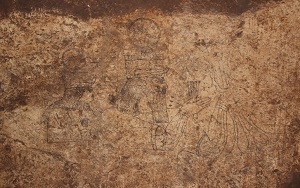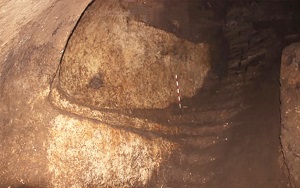Secret beneath a home reveals Iron Age mysteries. An unexpected discovery has revealed ancient artwork that was once part of an Iron Age complex beneath a house in southeastern Turkey.
This unfinished structure serves as a procession of deities depicting how different cultures came together.
Thieves broke into the underground complex in 2017 by creating a hole in the ground floor of a two-story house in the village of Başbük. The room, carved in the limestone base, stretches 99 feet (32 meters) below the house.
When the thieves were caught by the police. However, a team of archaeologists did an abbreviated rescue excavation to study the significance of the underground complex and rock art in the summer of 2018. What the researchers did The findings were shared in a study published Tuesday by the journal Antiquity.
These artworks have been created since the 9th century BC during the Neo-Assyrian Empire. During this period, the Neo Assyrian Empire began in Mesopotamia and expanded to become the largest powerful state at the time.

This expansion included Anatolia, a large peninsula in Western Asia that included much of present-day Turkey, between 600 and 900 BC.
Study author Selim Ferruh Adali, an associate professor of history at Ankara University of Social Sciences in Turkey, said: “As the Assyrian Empire exercised political power in Southeast Anatolia, the Assyrian governors could their power through Assyrian court art”. declare.
An example of this style is the carving of the period itself in monumental stone reliefs, but Neo-Assyrian examples are rare, the study authors wrote.
Combining different cultures
Table of Contents
ToggleThese works reflected the integration of cultures instead of outright conquest. The secret below is the illustrations.
According to factual observations, the Gods have their names written in the local Aramaic language.
The Images and inscriptions depict religious themes from Syria and Anatolia and were created in the Assyrian style.
“It shows that during the early Neo-Assyrian period that controlled the area, there was local coexistence and symbiosis of Assyrians and Arameans in an area,” says Adali. “The Başbük Council provides scholars studying the nature of empires with an outstanding example of how regional traditions can maintain a voice and are important in the exercise of imperial power. through monumental art.”
The artwork shows a total of eight gods. The images and descriptions of these 8 gods are not complete. The largest one is 3.6 feet (1.1 meters) tall. Local deities in the artwork include the moon god Sîn, the storm god Hadad, and the goddess Atargatis. Behind them, the researchers were able to identify a Sun god and other deities.

The different descriptions made it possible for the researchers to combine symbols of Syro-Anatolian religious significance with representative Assyrian elements, Adali said.
“The inclusion of Syro-Anatolian religious themes (illustrated) an adaptation of Neo-Assyrian elements in ways one would not expect from previous findings,” says Adali.
“They reflect an earlier period of Assyrian presence in the area when local elements were more emphasized.”
When this artwork was discovered, study author Mehmet Önal, a professor of archeology at Harran University, Turkey, said, “When the dim light of the flashlight revealed the deities. , I trembled with fear when I found myself facing the very expressive eyes and majestic face of the storm god Hadad.”
“I was shocked to see Aramaic inscriptions on such artwork, and a sense of great excitement overtook me as I read the names of the deities,” Adali said.
Don't Miss:
No related posts.







